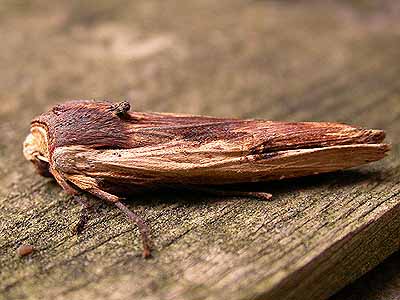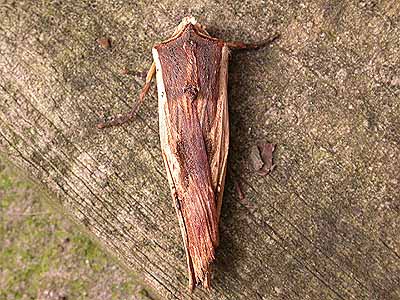

| The Red Sword-grass at Eakring and Kersall | ||
| The capture
of two adult Red Sword-grass (Xylena vetusta) at
MV light in early 2004 and 2005, are important records
from the area. They also again emphasise the importance
of regular moth-trapping from any particular site or
area, and the potential results available. This page briefly looks at the status of the Red Sword-grass on both a local and national scale, recent (2004/2005) records from across the UK and circumstances of the records here. Many people from across the UK have contributed their recent sightings and their assistance is much appreciated. Life-cycle The adult Red Sword-grass hatches during September and November - reappearing after hibernation the following March or May when pairing occurs. It favours damp or wet areas, such as boggy heathland, damp woodland, rough upland pasture and marshes. The larvae feed on a range of plants including Bog Myrtle, Yellow Iris, sedges and the flowerheads of both Soft-rush and Compact Rush. |
 |
|
| ............... | ||
| UK
status and distribution Waring, Townsend and Lewington in their Field Guide to the Moths of Great Britain and Ireland, describe the Red Sword-grass as being "a resident and possible immigrant, being local and fairly well distributed. Frequent in many parts of mainland Scotland, northern England, the Isle of Man and Ireland" With such a distinct northerly bias across it's UK range, the Red Sword-grass (Xylena vetusta) is considered rare as a resident in southern England, with the New Forest perhaps representing a rather weak southerly stronghold. There are many widely scattered records from all over the south of the UK, whiich are considered to be migrants. There are a few records from the Midlands and East Anglia, and it is perhaps likely that some of these records could be wandering individuals from breeding populations further west or (more likely) migrants as those from more southerly locations. Current status of the Red Sword-grass in Nottinghamshire The Red Sword-grass is then, a very rare moth in Nottinghamshire and given Grade 2 (possibly now Grade 1) status. Over the last few decades, the species has only been reported at Ivy blossom from a Misterton garden during the 70's, 80's and 90's (per Dr Sheila Wright) One can presume that the only recent Nottinghamshire records all refer to pre-hibernating adults, due to the Autumn flowering period of Ivy. Eakring records The trapping of an adult Red Sword-grass at Hare Hill Wood on April 24th 2004, is consequently of great significance on a local level. Not only is it possibly one of (or) the first accurately documented Nottinghamshire record since the 1960's, but also suggests that there could perhaps be a small population within a reasonable distance of capture. The moth was trapped on a mild, clear night. Despite the favourable conditions, it was one of a relatively small number of moths attracted to the operating MV light and appeared at 22:45h. The possibilty that this moth was a migrant is believed very unlikely. It's condition was very fresh, with little wear on the wings noted and there was minimal migrant activity on the south coast around the date of capture. A second Red Sword-grass was taken at MV light on February 17th 2005, from Lound Wood. It now looks certain to be breeding in the area and more work will be conducted on any possible population during 2005. Recent UK records Until the early part of 2005, a lack of recent records from across much of England, showed just how rare the moth is as a breeding species. It is certainly as likely to occur in light traps as a migrant, than as local wanderers from nearby breeding sites. The moth is however, recorded fairly regularly in northern England, but is much commoner (or regularly recorded) in Scotland, Ireland and Wales. Overall, there appear to be far more sightings during the Spring and the favoured time to record the Red Sword-grass across the UK, is from mid-March through to the end of April/early May. |
||
| ............... | ||
| In neighbouring counties
the Red Sword-grass is very rare. There appear to be no
recent Derbyshire records and an adult found crushed in a
door frame at Loughborough on May 13th 2003, was the
first Leicestershire record for over 70 years (per
Mark Skevington) Many UK records are (or have been) presumed to relate to migrants and at the end of April 2004, there had been just two migrant records - from St Mary's on the Isles of Scilly on March 28th 2004 and at Burnham-on-Sea, Somerset on March 31st 2004. In the past it has been recorded at Durlston Country Park, Dorset on December 22nd 2002 and Fernham, Oxon on October 21st 2001. Both these specimens were taken with more familiar migrants, including a Vestal at Fernham (per Steve Nash). The Burnham-on-Sea record was a new one at the time for the group of traps situated along that narrow coastal strip. But in the immediate local area, there were records in three of the adjacent 10k squares during 2003 (per James McGill). |
 |
|
| ............... | ||
Records from Ireland were more forthcoming when I put out a request for Red Sword-grass records and I received two series' of records. In Co Wicklow, there have been seven Red Sword-grass records within the period March 14-April 26th 2002-2004 (per Angus Tyner) In the north-west of Ireland, the moth has been recorded on eight occasions (13 adults) between March 21st and April 29th 2000-2004, the only Autumn record was of an adult on October 15th 2003 (per Craig Ayres) In Scotland, the only 2004 records received were from Aberdeenshire, where the moth has been recorded on two or three occasions, but does occur (as in Ireland) with far more regularity, than from more southerly UK sites (per Chris Harlow) The first few months of 2005 have seen a significant upturn in Red Sword-grass records, leading to the theory that the moth is currently increasing it's range. Interestingly, many of the records have come from sites within agricultural habitat. This would fit perfectly with the Eakring and Kersall area's records. Leicestershire recently recorded it's first live adult since 1935 - taken at light at Fox Covert, Ulverscroft on 9th March 2005. This site is very close to where the 1935 individual was taken, and not too far from Loughborough, where an adult was found crushed. Other Midlands records quickly followed during the early months of 2005, including the fourth and fifth ever for Worcestershire and the third Warwickshire record since 1904. Staffordshire also produced it's fourth record since 1930. A Red Sword-grass was also taken at light from Fernham (Oxon) and is only the second VC22 record in the last 50 years. Thanks to the following people who have supplied information and records for use in this article: Dr Sheila Wright, Mark Skevington, Steve Nash, James McGill, Craig Ayres and Angus Tyner References: Waring, Townsend and Lewington Field Guide to the Moths of Great Britain and Ireland BWP 2003 |
||